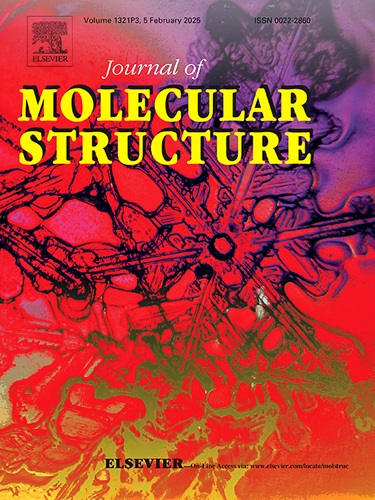二阳离子[CuII(Py2C(OH)2)2]2+的 SC-XRD 研究:明显的贾恩-特勒畸变、二维-S12/S9/S7 合子、XRD/HSA-相互作用、热、光谱、抗炎和对接潜力
IF 4
2区 化学
Q2 CHEMISTRY, PHYSICAL
引用次数: 0
摘要
用二(吡啶-2-基)甲酮(Py2CO)配体处理 Cu(NO3)2-3H2O,产生了[CuII(Py2CO)2](NO3)2 中间络合物,并首次引入了二元醇[CuII(Py2C(OH)2](NO3)2-H2O 二阳离子络合物,产量可观。在配位 Cu(II) 中心的同时,py2CO 原位水解,通过附带的水溶剂形成二(吡啶-2-基)甲二醇 Py2C(OH)2。因此,[CuII(Py2C(OH)2](NO3)2-H2O 的分子式通过一系列分析工具(包括 XRD 晶体学)得到了证实。X 射线衍射分析表明,[CuII(Py2C(OH)2](NO3)2-H2O 具有一个高度畸变的八面体 Cu(II) 核心,该核心被四个 N-吡啶包围,呈 CuN4 正方形排列。Py2C(OH)2的2-羟基占据了Cu(II)中心的反Z轴位置,代表了一个显著拉长的雅恩-特勒畸变八面体几何结构。除了一个水分子之外,4-羟基和 2-硝基官能团的存在在构建相互连接的紧凑晶格方面发挥了有趣的作用,因为有记录表明,通过大量的 H 键构建了多个 2D-S12/S9/S7 合子。此外,这些合子的存在对复合物的稳定性也有积极的影响,因为它表现出很高的热稳定性。抑制脂氧合酶 (LOX) 和环氧合酶 (COX-1 和 2) 的作用被用来评估所需复合物的抗炎抑制作用,此外,硅学对接被用来从理论上阐明 COX/LOX 的抗炎结果。本文章由计算机程序翻译,如有差异,请以英文原文为准。
SC-XRD investigation of Oh dicationic [CuII(Py2C(OH)2)2]2+: A significant Jahn Teller distortion, 2D-S12/S9/S7 synthons, XRD/HSA-interactions, thermal, spectroscopic, anti-inflammatory and docking potential
Treating of Cu(NO3)2·3H2O with di(pyridin-2-yl)methanone (Py2C![]() O) ligand resulted the [CuII(Py2CO)2](NO3)2 intermediate complex was first introduced the diol [CuII(Py2C(OH)2](NO3)2·H2O dicationic complex in a significant yield. In situ py2C
O) ligand resulted the [CuII(Py2CO)2](NO3)2 intermediate complex was first introduced the diol [CuII(Py2C(OH)2](NO3)2·H2O dicationic complex in a significant yield. In situ py2C![]() O hydrolysis while coordinating the Cu(II) center, forming di(pyridin-2-yl)methanediol Py2C(OH)2, via incidental water solvent. Accordingly, the [CuII(Py2C(OH)2](NO3)2·H2O formula was confirmed using a range of analytical tools, including XRD-crystallography. The XRD analysis revealed that the [CuII(Py2C(OH)2](NO3)2·H2O had a highly distorted octahedral Cu(II) core that was surrounded by four N-pyridines occupying the square planar CuN4 arrangement. The 2‑hydroxyl group of Py2C(OH)2 occupied the trans-Z-axial position of the Cu(II) center, representing a significantly elongated Jahn Teller distortion octahedral geometry. The presence of the 4‑hydroxyl and 2-nitro functional groups, in addition to one water molecule, played an interesting role in building the interconnected and compact lattice since several 2D-S12/S9/S7 synthons constructed via a numerous number of H-bonds have been recorded. Moreover, the presence of such synthons reflected positively in the stability of the complex, as it demonstrated high thermal stability. Lipoxygenase (LOX) and cyclooxygenase (COX-1 and 2) inhibition were used to evaluate the desired complex as anti-inflammatory inhibitory, moreover, in silico docking was used to clarify theoretically the COX/LOX anti-inflammatory result.
O hydrolysis while coordinating the Cu(II) center, forming di(pyridin-2-yl)methanediol Py2C(OH)2, via incidental water solvent. Accordingly, the [CuII(Py2C(OH)2](NO3)2·H2O formula was confirmed using a range of analytical tools, including XRD-crystallography. The XRD analysis revealed that the [CuII(Py2C(OH)2](NO3)2·H2O had a highly distorted octahedral Cu(II) core that was surrounded by four N-pyridines occupying the square planar CuN4 arrangement. The 2‑hydroxyl group of Py2C(OH)2 occupied the trans-Z-axial position of the Cu(II) center, representing a significantly elongated Jahn Teller distortion octahedral geometry. The presence of the 4‑hydroxyl and 2-nitro functional groups, in addition to one water molecule, played an interesting role in building the interconnected and compact lattice since several 2D-S12/S9/S7 synthons constructed via a numerous number of H-bonds have been recorded. Moreover, the presence of such synthons reflected positively in the stability of the complex, as it demonstrated high thermal stability. Lipoxygenase (LOX) and cyclooxygenase (COX-1 and 2) inhibition were used to evaluate the desired complex as anti-inflammatory inhibitory, moreover, in silico docking was used to clarify theoretically the COX/LOX anti-inflammatory result.
求助全文
通过发布文献求助,成功后即可免费获取论文全文。
去求助
来源期刊

Journal of Molecular Structure
化学-物理化学
CiteScore
7.10
自引率
15.80%
发文量
2384
审稿时长
45 days
期刊介绍:
The Journal of Molecular Structure is dedicated to the publication of full-length articles and review papers, providing important new structural information on all types of chemical species including:
• Stable and unstable molecules in all types of environments (vapour, molecular beam, liquid, solution, liquid crystal, solid state, matrix-isolated, surface-absorbed etc.)
• Chemical intermediates
• Molecules in excited states
• Biological molecules
• Polymers.
The methods used may include any combination of spectroscopic and non-spectroscopic techniques, for example:
• Infrared spectroscopy (mid, far, near)
• Raman spectroscopy and non-linear Raman methods (CARS, etc.)
• Electronic absorption spectroscopy
• Optical rotatory dispersion and circular dichroism
• Fluorescence and phosphorescence techniques
• Electron spectroscopies (PES, XPS), EXAFS, etc.
• Microwave spectroscopy
• Electron diffraction
• NMR and ESR spectroscopies
• Mössbauer spectroscopy
• X-ray crystallography
• Charge Density Analyses
• Computational Studies (supplementing experimental methods)
We encourage publications combining theoretical and experimental approaches. The structural insights gained by the studies should be correlated with the properties, activity and/ or reactivity of the molecule under investigation and the relevance of this molecule and its implications should be discussed.
 求助内容:
求助内容: 应助结果提醒方式:
应助结果提醒方式:


